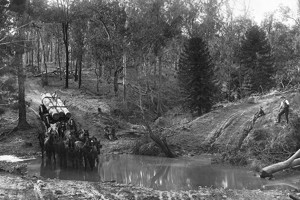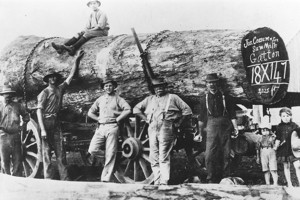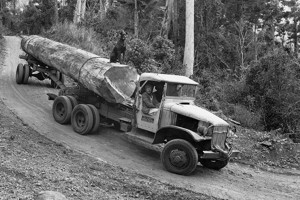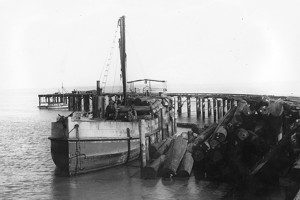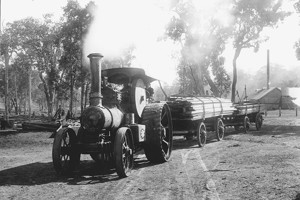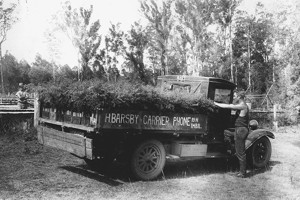More than a century of continuous forest management

We really have been growing for generations and hope to continue to grow for generations to come. While HQP as a company has only managed Queensland’s plantation forests since 2010, we are proud to be associated with forest management in Queensland spanning more than 100 years.
Commercial forest production has been of prime importance to Queensland since at least 1900, when Leonard G. Board became Queensland’s first Inspector of Forests.
Inspector Board was the first in a long line of forestry leaders who progressively refined forest management to a commercial science, balancing ecological and environmental needs with community benefits such as timber, employment and recreation.
From the early years of settlement, when forests were heavily logged, through to the first hesitant steps of forest conservancy and today’s rapid strides in technology, research and development, the story of forestry in Queensland is one of constant evolution – and it’s one we continue to play a key role in.
In 2010, we acquired a 99-year licence from the Queensland Government to manage, harvest and grow these plantations. But of course, our people’s connection to the land stretches back long before that.
Many of our employees, past and present, have worked in these plantations for 20, 30, 40 and even 50 years, and some have parents and grandparents who also worked here before them. Maybe one day their children and grandchildren will work here, too.
Here’s a little bit of Queensland's and our plantation forest history.
My father worked in forestry for 48 years before he retired. My mother worked here, too, as well as my sisters, my wife and even my daughter for a while. Dad was a nursery supervisor so he grew the trees and when I was in the field I planted the trees. In the role I’m in now, I’m protecting the trees. The trees I planted have mostly all been harvested and the next generation is growing.
Queensland's plantation forest history
-
In 1823, Surveyor-General John Oxley sailed into the Brisbane River and saw “timber… of great abundance”. In 1842, after 17 years as a penal depot, free settlers began to colonise areas to the north and west of Brisbane.
Much timber was needed in the colony for housing, boat-building, fencing and other development. Responding to these needs, William Pettigrew opened Brisbane’s first sawmill in 1852.
At this time, Queensland forests were heavily logged for pine, cedar and other hardwoods.
-
Responding to early concerns about the effects of unplanned forest utilisation, the Government proclaimed its first timber regulations in 1860. The regulations were amended in 1862 to add the threat of log seizure as the punishment for non-compliance, and in 1870, the first timber reserves were gazetted.
Archibald McDowall, the then-District Surveyor at Maryborough and later Surveyor-General of Queensland, became an advocate of forest conservancy and management within the Department of Public Lands. McDowall showed great vision, and led the push to protect forests from overcutting and wastage.
In 1890, the Government called for reports on forestry matters from a group of four Commissioners, who recommended a forest management plan that emphasised conservancy, regeneration and the extension of forests into treeless areas.
-
In 1900, a Forestry Branch was created in the Department of Public Lands. Leonard G. Board was appointed the Inspector of Forests, with support from two forest rangers in the field.
At the time the Forestry Branch was created, Queensland had about a million and a half acres of forest reservation. That figure doubled within two years, and had risen to well over three and a half million acres by the end of 1904.
The State Forests and National Parks Act was enacted in 1906, giving the Governor-in-Council the authority to reserve Crown lands as State Forests and National Parks, and in 1908, the first National Parks were declared at Bunya Mountains and Tamborine Mountain.
-
During the tenure of N.S. Jolly as Director of Forests, from 1911 to 1918, forestry began to take on a professional image for the first time.
The need for a “determination of annual cut permissible” was proclaimed in 1911, and over the course of the decade, the seeds of a new forestry were sown with the introduction of forest inventory surveys, yield calculation, silvicultural research trials, timber technology and rudimentary fire protection.
-
Larger-than-life forest visionary Edward Swain was made Director of Forests in 1918, and soon established Queensland’s first forest nurseries and plantations. By the end of the 1930s, nearly 20,000 acres of softwood had been planted in Queensland.
Swain wrote silvicultural manuals based on Australia’s climate, rather than Europe’s, and played an instrumental role in identifying Slash Pines and Loblolly Pines as being suitable for Queensland’s climate. With Swain dictating the curriculum, silvicultural techniques were standardised throughout the 1920s, and by the end of the 1930s, large-scale native forest silvicultural operations were underway throughout south-east Queensland.
In 1926, the Forestry Branch finally regulated the amount of timber that could be cut by the industry in state forests and timber reserves, while the Sawmill Licensing Act of 1936 regulated the burgeoning sawmilling industry.
A staunch conservationist, Swain fiercely opposed the state government’s plan to open the hardwood forests of north Queensland for settlement in the early 1930s. Although his views were eventually adopted by the government, he had ruffled too many feathers, and was dismissed without compensation four years before his contract was to expire.
-
During World War II, the construction of defence installations placed a heavy burden on timber supplies. Forestry was regarded as an essential industry, and measures were taken to ensure timber was available for the war effort. With a shrinking male labour force, European prisoners of war were used to harvest Queensland’s timber.
After the war, chainsaws became the main implement of tree feeling, and productivity skyrocketed. At the same time, reconstruction efforts made the need for timber even greater. European refugees began to be resettled in Australia from 1947, under the condition that they had to work for two years in employment directed by the Commonwealth Government. Roughly 1000 refugees were employed by the Department of Forestry in Queensland between 1947 and the end of the scheme in 1952, primarily as part of a massive reforestation program.
While many refugee workers gravitated to coastal towns and cities at the end of their two-year employment period, others chose to remain employed by the forestry department.
-
The Forestry Act, passed in 1959, enshrined the cardinal principles of forest management – the permanent reservation of forests, producing timber and associated products in perpetuity, and protecting a watershed therein.
During 1963-64, the amount of plantation-grown hoop pine that was cut exceeded natural hoop pine for the first time. Forestry officers, however, believed the planting rate should be increased by 50%, leading to the inauguration of the Australian Forestry Council, which boosted the annual softwood planting program to 10,000 acres.
Throughout the 1960s, 70s and 80s, as freehold policies allowed private citizens to purchase large tracts of crown-owned land, the forestry department challenged freehold applications to retain the best segments of land as state forests in the public interest.
In 1975, the national parks section of the Department of Forestry became a separate entity, the Queensland Parks and Wildlife Service, to manage over one million hectares of national parks estate.
As the conservation movement grew, struggles for ownership and stewardship of forest estate became more vociferous and widespread. This eventually led to Regional Forest Agreements – 20-year plans for the conservation and sustainable management of Australia's native forests – being signed between 1997 and 2001.
-
While the forestry department once had responsibility for almost all forest-related activities in Queensland, including national parks, forestry management is now spread across several Queensland Government agencies – and the private sector.
In 2006, the Queensland Government’s plantation and native forest operations were separated, with the establishment of Forestry Plantations Queensland, a government-owned corporation, to manage its commercial plantation forest operations.
This restructuring culminated in 2010 with the sale of Forestry Plantations Queensland, when HQPlantations acquired a 99-year licence from the Queensland Government to manage, harvest and grow timber plantations on state land.
Our management of these plantations is informed and underpinned by more than a century’s worth of history, conservancy and technological progress.
With our long-term, sustainable approach to forest management, we are excited to be the stewards of these plantations forests for the better part of the next century, growing superior quality, locally grown, renewable wood for generations to come.

